1. Introduction and Plant Tissues
- Books Name
- Yash Tyagi Coaching Science Book
- Publication
- ACERISE INDIA
- Course
- CBSE Class 9
- Subject
- Science
Chapter-2
Tissues
Introduction and Plant Tissues
Introduction
As you all know that we have a complex body organization starting from cellular level to a well-developed individual. If we look at the hierarchy of organization we see that:
Cells → Tissue→ organ→ organ system→ organism
As far as cells are concerned, we have studied that cells are structural and functional units of life. The cells, when formed, undergo the process of differentiation according to the functions that they will perform. The cells that have the same structure, features and perform the same functions form a particular type of tissue. Let us start with the chapter where we will learn all about it.
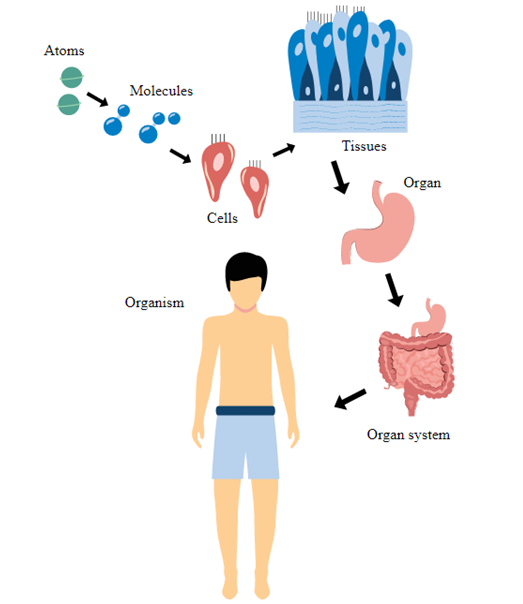
The cells which are specialized in a function are grouped together and form a particular type of tissue. We have different tissues in our body that performs different functions like:
1. They play the role of protection.
2. They help in control and coordination.
3. They help in transportation.
4. They act as insulators.
5. Many more functions are performed.
Let us learn about Plant tissue
Types of plant tissues
They are classified into mainly two types as given below
- Meristematic tissue
- Permanent tissue
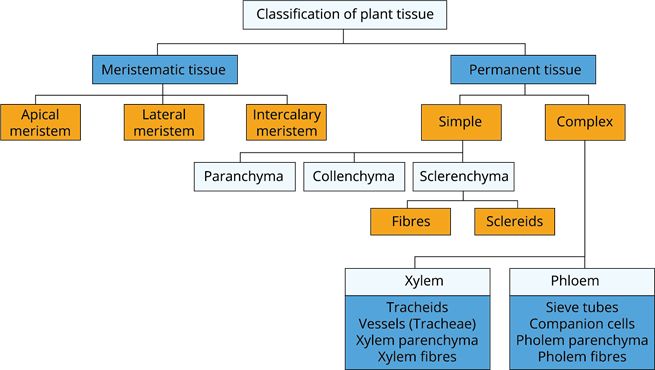
Meristematic tissue and its types
You all have seen that plants have a tendency to grow and keep growing throughout their life. This is because of certain cells in it that keep on dividing and they are called meristematic cells. Let us learn about them. They are formed of cells that have the ability to divide continuously throughout their life and help in increasing the length and girth of the plant.
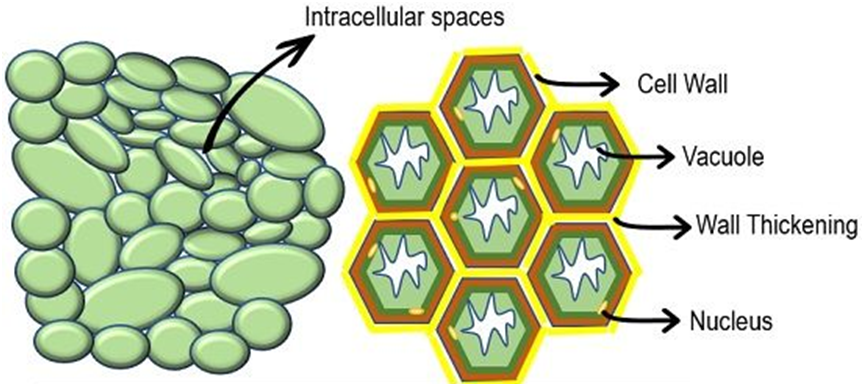
Characteristics of meristematic cells
- They have thin cellulose cell walls.
- The meristematic cells may be spherical, oval, polygonal or rectangular in shape. The meristermatic cells are compactly arranged.
- Each meristematic cell contains dense or abundant cytoplasm and a single large nucleus.
- The meristematic cells contain few vacuoles or no vacuoles at all.
Occurrence
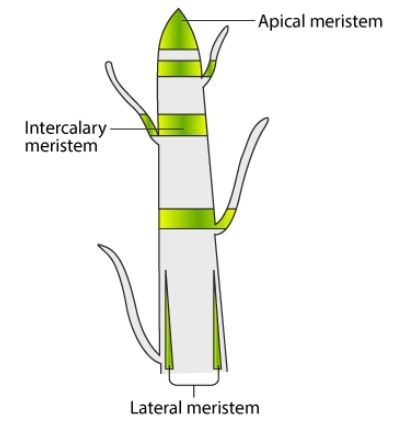
According to their position in the plant, meristems are of three types:
- Apical meristem
- Lateral meristem
- Intercalary meristem
Apical meristems
- It is present at the growing tip of stems and roots. It is at shoot apex and root apex.
- Its function is to increase the height of the plant.
Lateral meristems
- These are found beneath the bark (called cork cambium).
- The function is to help increase in diameter.
Intercalary meristems
- It is located at the base of leaves or at internodes.
- Its function is to increase the number of branches.
2. Permanent Tissues
- Books Name
- Yash Tyagi Coaching Science Book
- Publication
- ACERISE INDIA
- Course
- CBSE Class 9
- Subject
- Science
Permanent Tissues
Permanent Tissues
There are certain meristematic cells that can not divide throughout their life. They actually lose their tendency to form new cells. As a result, they form another tissue that is Permanent. They have particular functions except forming new cells. These tissues are derived from the meristematic tissue but their cells have lost the power of division. They are of two types:
- Simple permanent tissue
- Complex permanent tissue
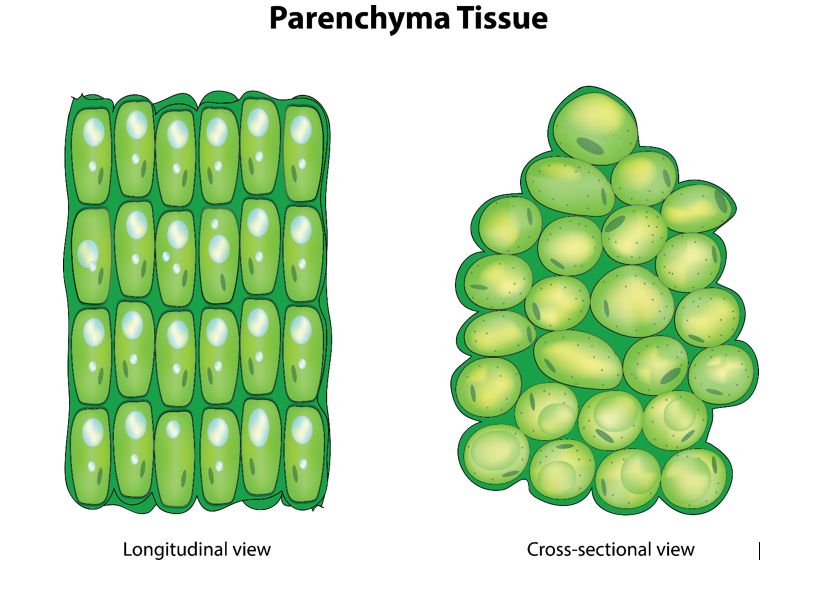
Simple permanent tissues
These tissues are composed of cells which are structurally and functionally similar. Thus, these tissues are all made of one type of cells. Depending upon the composition and function they are further classified into three types:
- Parenchyma
- Collenchyma
- Sclerenchyma
Let us learn about the difference between the three:
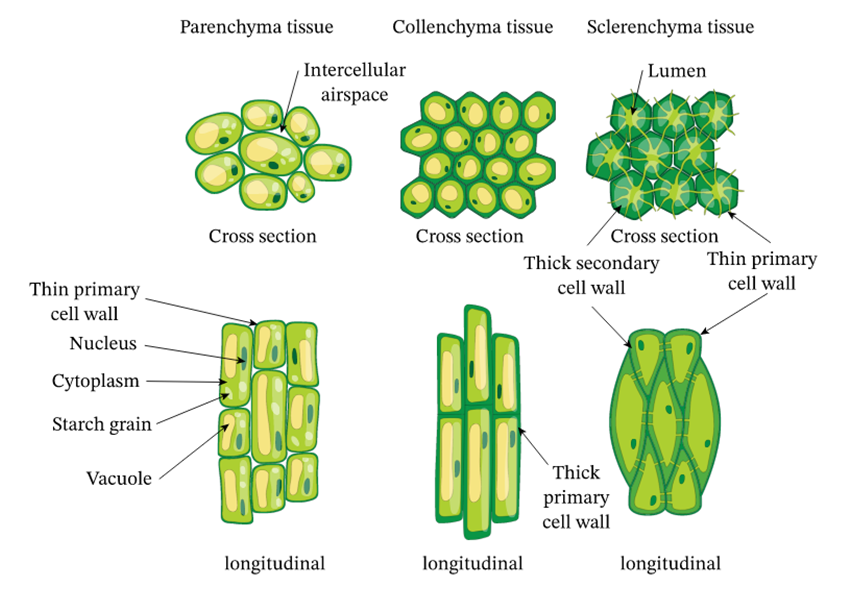
Parenchyma
This tissue is widely distributed in plant body such as stem, roots, leaves, flowers and fruits. It performs various functions and also has distinct features in xerophytes and hydrophytes. Let us see the features it possesses.
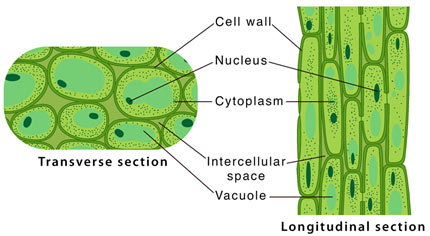
Characteristics
- Parenchyma cells are living and possess the power of division.
- The cells are rounded or isodiametric that isequally expanded in all sides.
- The parenchymatous cells are oval, round, polygonal or elongated in shape.
- The cell wall is thin and enclosed but dense cytoplasm which contains a small nucleus.
- Intercellular spaces are present
Functions
1. Parenchyma serves as a packing tissue.
2. Parenchyma acts as the main support to the stem.
3. Parenchyma serves as food storage tissue.
4. It helps in transporting materials.
5. It allows gaseous exchange.
6. It stores waste products of plants.
7. If chloroplast is present, the parenchyma tissue is called chlorenchyma and it helps in performing photosynthesis.
8. In hydrophytes large air cavities present called arenchyma that provide buoyancy to plants.
Collenchyma
You must have seen that some plant parts can bend without breaking. This feature is due to the presence of a mechanical tissue called collenchymas. They are generally found below epidermis of dicot stem and petiole. They also occur in midribs of dicot leaves but are absent in monocots.
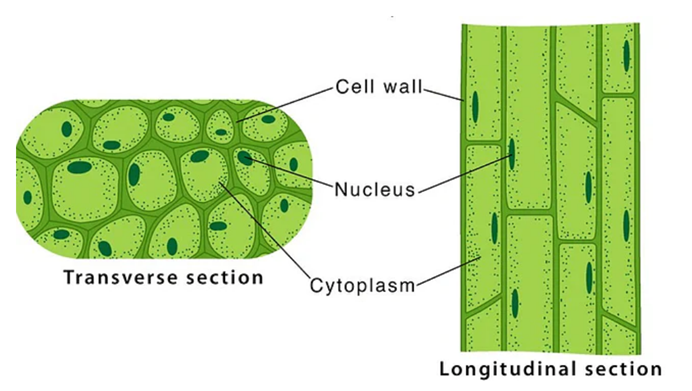
Characteristics
- They are living cells.
- They are characterized by the deposition of extra cellulose at the corners of the cells.
- The intercellular spaces are generally absent.
Functions
- It is a mechanical tissue so, it provides mechanical support to plant and its parts.
- It also provides strength and flexibility.
Sclerenchyma
You all have used and seen coconut for various purposes like performing some rituals, for eating, drinking coconut water, etc. The husk that is found outside the coconut looks like thin fibres and is hard too. This is made up of cells that is Sclerenchyma. Let us study about it.
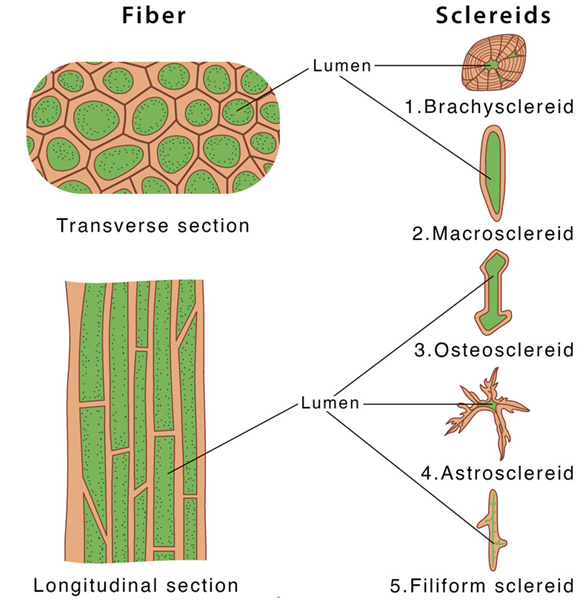
Characteristics
- They are actually dead cells.
- The walls of these cells are thickened with deposition of lignin.
- There are no intercellular spaces.
Cells of sclerenchyma are basically of two types:
- Fibres
- Sclereids
Fibres: They consist of very long, narrow, thick and lignified cells. They are usually pointed at both ends.
Sclereids: They are irregular in shape. They are also dead and are found under different parts like cortex, pith, phloem, etc.
Both fibres and sclereids have thin areas on them that are called pits.
Functions
- They provide mechanical support andare protective in nature.
Protective tissue
Plants and plant parts also need protection from external factors. So, there are certain tissues that perform this action. Let us learn about them. It includes epidermis and cork (or phellem).
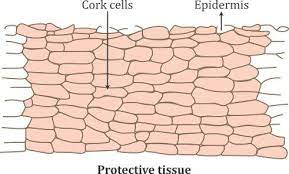
Epidermis
Epidermis is one cell thick layer and is covered with cuticle. It is a waterproof layer as it has a waxy substance called cutin. The cells of the epidermis are elongated and flattened and do not contain any intracellular space. Function of the epidermis is to protect the plant from desiccation and infection.
Cork
As plants grow older, epidermis undergoes certain changes and transforms into phellogen or cork. The cambium cells of cork are rectangular and are dead. The walls of cork cells are heavily thickened by the deposition of suberin which makes these cells impermeable to water and gases. Cork cells prevent desiccation, infection and mechanical injury.
Stomata
Epidermis of a leaf has small pores, called stomata. Each stoma is bounded by specialized epidermal cells called guard cells. These Guard cells are the epidermal cells only and contain chloroplasts. The stoma allows gaseous exchange to occur during photosynthesis and respiration.
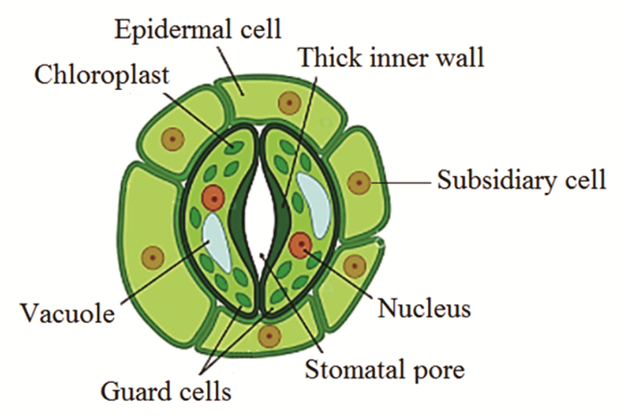
Complex permanent tissues
You all know that green plants can carry out photosynthesis and also absorb water through roots. But it may make you curious to know that how these substances are transported to whole plant. As we know, they don’t have blood, lymph or so. It is due to this complex tissue that water is transported and food is translocated. Let us learn about it. They consist of more than one type of cells. They are of the following two types:
- Xylem
- Phloem
Xylem and phloem are popularly known as vascular tissues
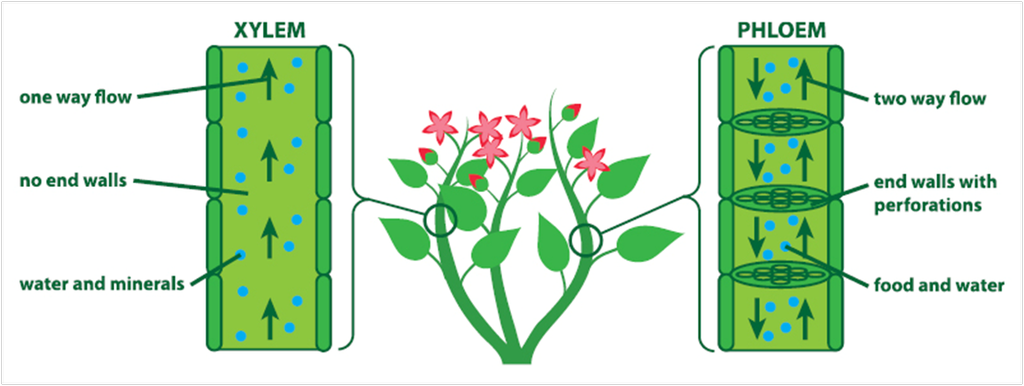
Xylem
Xylem is composed of cells with four different parts:
- Tracheids
- Vessels
- Xylem parenchyma
- Xylem sclerenchyma.
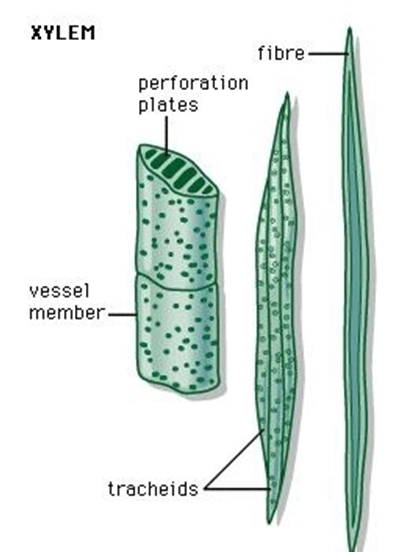
Except xylem parenchyma, all other xylem elements are dead and bounded by thick lignified walls. Vessels are shorter and wider than tracheid. Vessels are very long tube-like structures. Tracheids are elongated cells with tapering ends. They also conduct water. Since, tracheids do not have open ends like vessel, so the water has to pass from cell to cell via the pits.
Functions
- The main function of xylem is to carry water and mineral salts upward from the root to different parts of shoots.
- Since walls of tracheids vessels and sclerenchyma of xylem are lignified they give mechanical strength to the plant body.
Phloem
It consists of four components:
- Sieve tubes
- Companion cells
- Phloem parenchyma
- Phloem fibres.
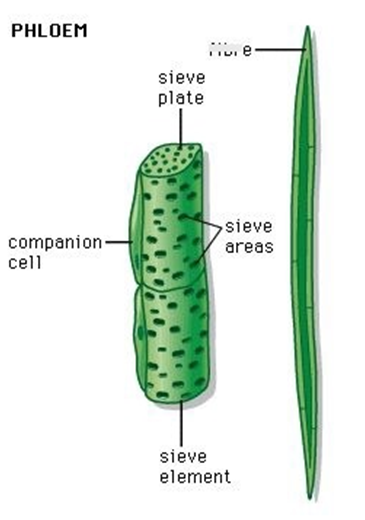
Sieve tubes
Sieve tubes are slenderical tube –like structures composed of elongated thin-walled cells, placed end to end. Their end walls are perforated by numerous pores and are called sieve plates.
Companion Cells
They are small thin-walled cells containing dense and very active cytoplasm and large elongated nucleus.
Functions
- Photo-synthetically prepared food materials are transported from the leaves to the storage organs.
3. Animal Tissues
- Books Name
- Yash Tyagi Coaching Science Book
- Publication
- ACERISE INDIA
- Course
- CBSE Class 9
- Subject
- Science
Animal Tissues
Animal Tissue
Man is multicellular, containing many organs and many systems operating in the body which help to carry out different activities like Breathing, Transportation of substances, Movement and many more. All these systems need different types of tissues that help perform these functions.
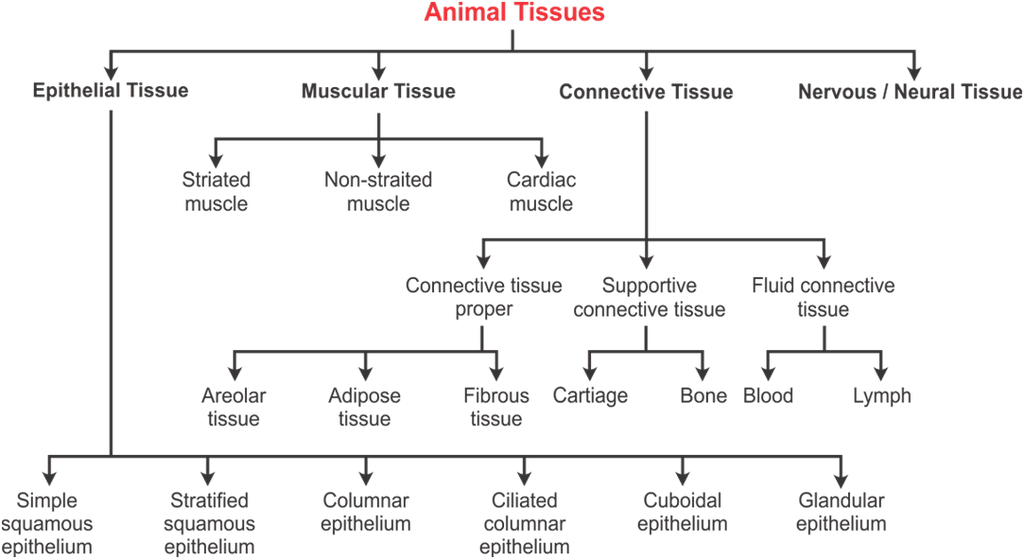
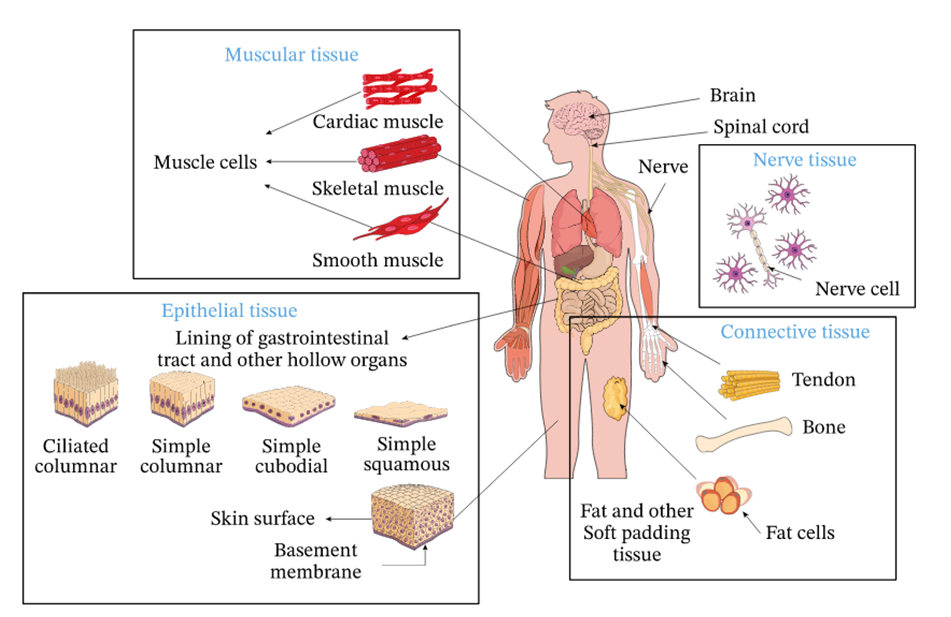
Epithelial tissue
This tissue forms the outer layer of all body parts. It is protective in nature as it acts a barrier to keep different organs separate. It is present almost everywhere like in skin, lining of buccal cavity, blood vessels, etc. The cells of this tissue are tightly packed and form a continuous sheet. Cells of epithelium contain very little or no intercellular matrix. Epithelial cells lie on a delicate non-cellular basement membrane which contains a special form of matrix that contains a protein called collagen.

Functions
- These cells protect the underlying cells.
- Epithelial cells form the lining of the mouth and alimentary canal and protect these organs.
- It helps in absorption of water and nutrients.
- It helps in the elimination of waste products.
- It also acts as a secretor.
Types of epithelial tissue
- Squamous epithelium
- Cuboidal epithelium
- Columnar epithelium
- Ciliated epithelium
Squamous Epithelium
You all are familiar with cavities of our body parts like mouth, esophagus, nose pericardium, alveoli, etc. and blood vessels. This tissue forms the lining of cavities of all these parts and also the covering of the tongue and skin. It is made up of thin, flat, irregular shaped cells which fit together like floor tiles to form a compact tissue.
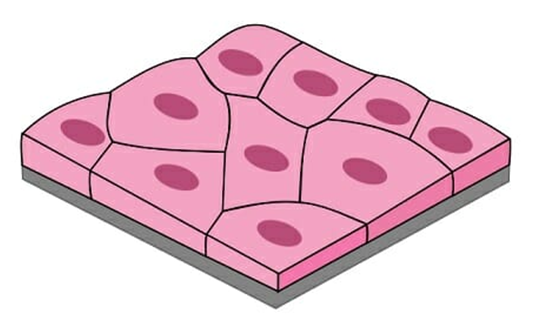
Function
- It protects the underlying parts of body from mechanical injury, entry of germs, chemicals and drying.
Cuboidal Epithelium
We all know that we have kidneys for purifying blood and also, vessels that run into or through it. This tissue forms those tubules and also the glands in our body that perform functions of secretion. It consists of cube-like (cubical) cells.
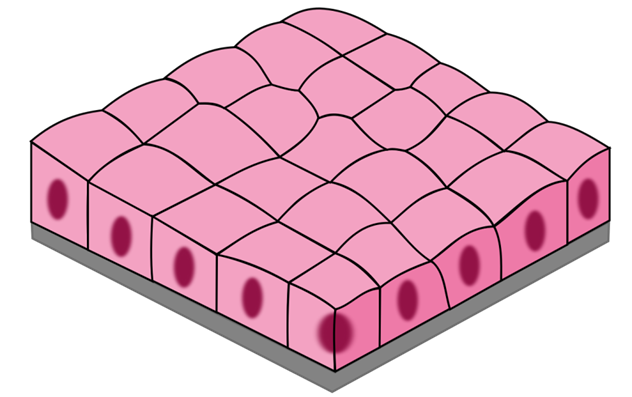
Functions
- It helps in absorption, excretion and secretion.
Columnar Epithelium
We all know that we have a slimy substance called mucus in our body that performs function in respiration activities and also in digestion activities. The mucus membrane is formed by it. It also forms lining of gall bladder and oviducts. It consists of cells which are taller in comparison to being broad. Their nuclei is towards the base and the free ends of cells contain thread – like structures called microvilli.
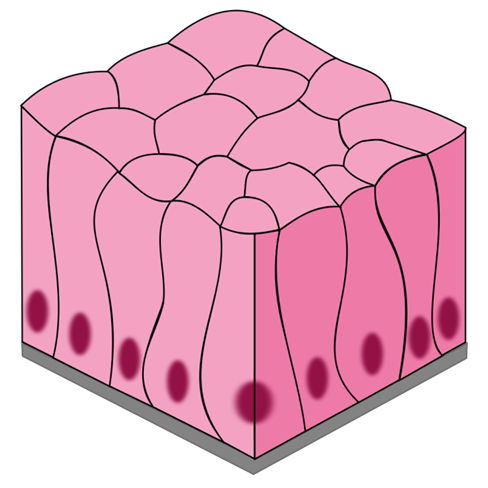
Ciliated Epithelium
In our body, substances are made to move like the ovum, air, etc. So, in our body, parts where propelling of substances takes place, there we have thread – like structures that act as propellers. They are villi. The villi are formed of these cells. They also line the trachea (wind-pipe), bronchi (lungs), kidney tubules and oviducts (Fallopian tubes). They are certain cubical or columnar cells that have a free border which bears thread-like cytoplasmic outgrowths called cilia. Such cells form the ciliated epithelium.
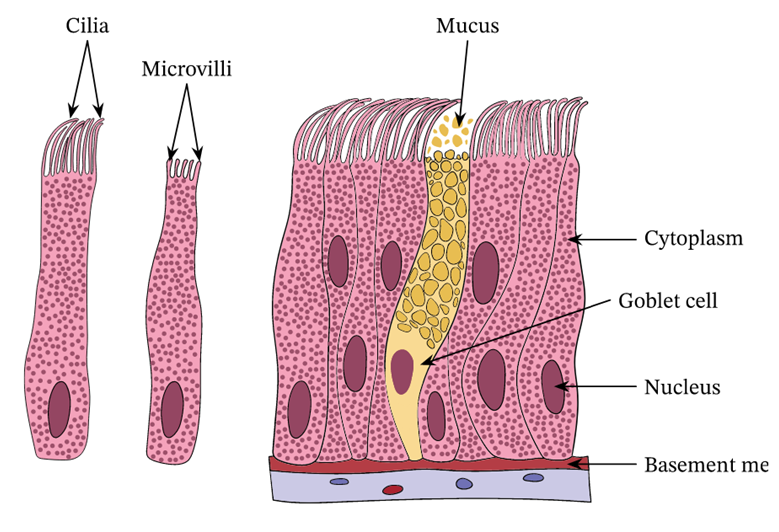
Function
- The rhythmic beating of the cilia moves solid particles in one direction through the ducts.
Muscle Tissue
We have 600 muscles in our body and they are contractile in nature. They help in bringing about movements in body parts. Like it helps us to move, it helps our heart to beat, it helps in bringing about all movements through our limbs. On the basis of their location, structure and functions there are following three types of muscle fibres:
- Striated muscles
- Smooth muscles
- Cardiac muscles
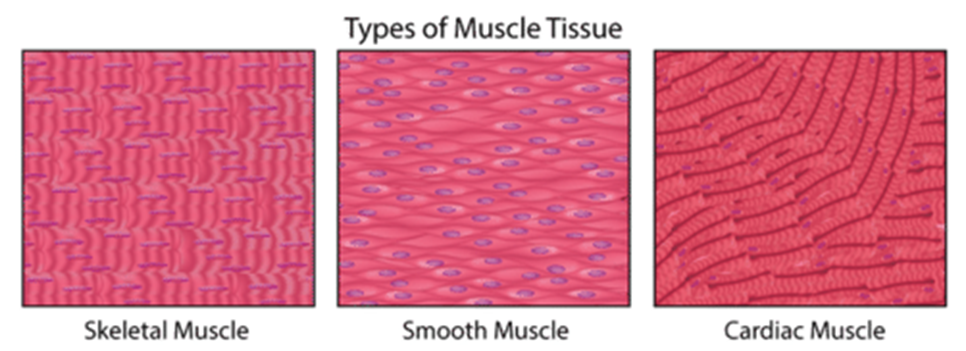
Striated Muscles
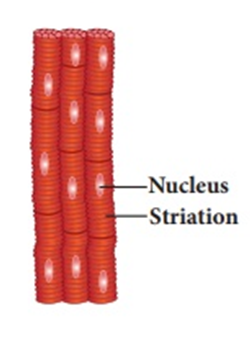
(Also called as Striped, skeletal or voluntary muscles) It is seen in muscles of limbs, body wall, neck, etc. Striated muscles are present in tongue, pharynx, diaphragm and upper part of the esophagus. They are called visceral striated muscles. It is cylindrical un-branched. These cells have a number of nuclei and each muscle cell is multinucleated. Each muscle cell is enclosed in a thin but distinct plasma membrane called sarcolemma and contain a fluid called sarcoplasm.
- The entire muscle fibres show alternate dark and light stripes. They are called striped muscles.
- They are attached to bones and are responsible for body movements they are called skeletal muscles.
- These muscles work according to our will. They are also called voluntary muscles.
- They are long or elongated with non-tapering ends.
Functions
- Striated muscles are powerful and undergo rapid contraction. These muscles can be tired and need rest.
- Striated muscles provide the force for locomotion and all other voluntary movements of the body.
Smooth Muscles
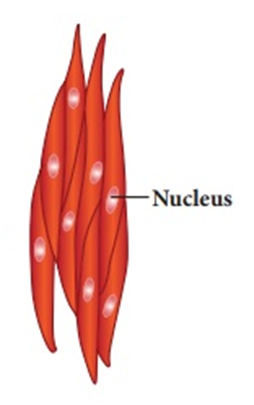
They are seen in the walls of the hollow (tubular) visceral organs except that of the heart that is why they are called visceral muscles.
- There is a single centrally located cigar-shaped nucleus in the centre of cytoplasm or sarcoplasm.
- These fibrils do not bear any bands , stripes or striations across the muscle hence, called smooth or unstrained muscles.
Functions
- Smooth muscles do not work and contract according to our will. So they are also called involuntary muscles. The movement of food in the alimentary canal, opening and closing of tubes are involuntary movements.
- Smooth muscles contract slowly but can remain contracted for a long period of time.
Cardiac Muscles
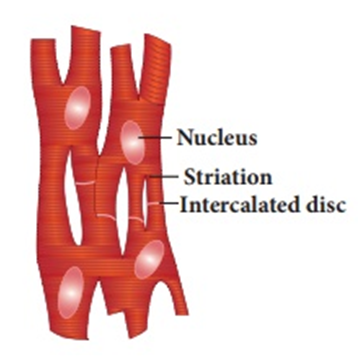
As you all know that we have an important organ that is heart and it keeps on pumping blood to all body parts without getting tired. It is because of a special muscle in it that is cardiac muscle. These muscles show the characteristics of both smooth and striated muscles. Cardiac muscles are composed of branched fibres, the branches join to form a network. Each fibre or cell is surrounded by sarcolemma and has cytoplasm (sarcoplasm) with longitudinal myofibrils and a centrally located nucleus. Cardiac muscles have stripes or light and dark bands. They show densely stained cross-bands called Intercalated discs.
Functions
- Cardiac muscles contract and relax rapidly.
- The contraction and relaxation of the heart muscles help to pump and distribute blood to various parts of the body.
Connective Tissue
The connective tissue is specialized to connect and anchor various body organs. It binds the tissue and gives support to various parts of the body by forming packing around organs so that they do not get displaced by body movements. They act as binding, supporting and packing tissue.
Its cells are living and separated from each other and are few in number. They have homogeneous gel-like intercellular substance called medium or matrix which forms the main bulk of the connective tissue. Thus, the space between cells is filled with the non-living matrix which may be solid like in bones and cartilages and fluids as in the blood. Matrix is fibrous in nature and binds other tissues in fact the nature of matrix decides the function of connective tissue.
Types of connective tissue In animals there are of following five types as given below:
- Areolar (loose) connective tissue
- Dense regular connective tissue
- Adipose tissue
- Skeletal tissue
- Fluid connective tissue
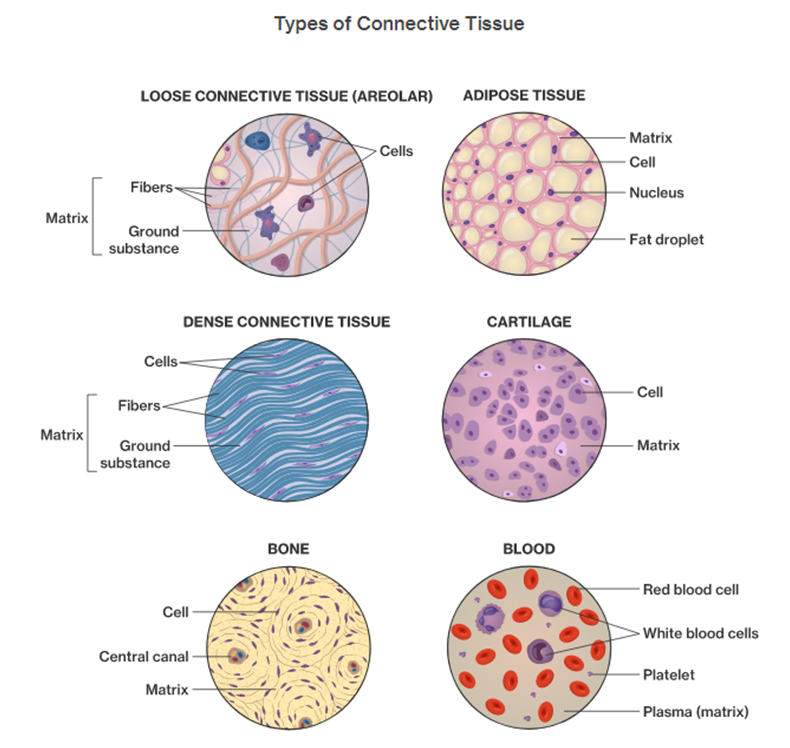
Areolar loose connective tissue
The tissue that joins skin to muscles and fills space inside organs is none other than the areolar connective tissue. It is a loose and cellular connective tissue. It has a matrix that consists of two kinds of fibres that is white collagen fibres and yellow elastic fibres or elastin.
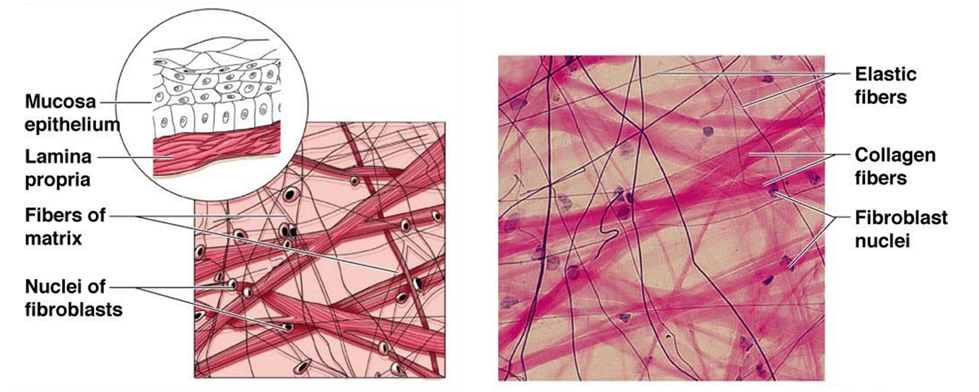
Functions
- It acts as a supporting and packing tissue between organs lying in the body cavity. Matrix of this tissue is important in diffusion of oxygen and nutrients from small blood vessels.
- It helps in repair of tissues after an injury.
- It also helps in combating foreign toxins.
- It fixes skin to underlying muscles.
Dense Regular Connective Tissue
It is a fibrous connective tissue. It is characterized by ordered and densely packed matrix composed of fibres and cells. It is of two types:
- Tendons
- Ligaments
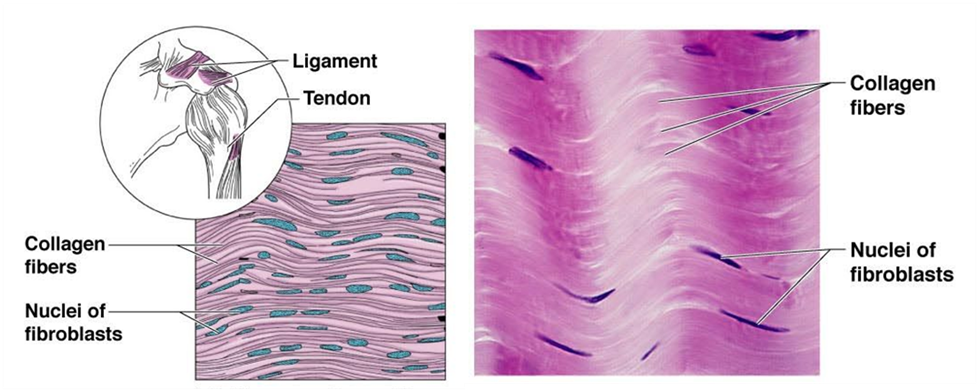
Tendons are cord-like, strong inelastic structures that join skeletal muscles to bones. They have great strength but their flexibility is limited. The cells of tendons are called tendinocytes.
Ligaments are elastic structures which connect bones to bones and have great strength but contain very little matrix. Sprain is caused by excessive pulling (stretching) of ligaments.
Adipose Tissue
This adipose tissue is abundant below the skin. It is the tissue that gives shape to our body and is a fat reservoir. Adipose tissue is basically an aggregation of fat cells or adipocytes. Each fat cell is rounded or oval and contains a large droplet of fat that almost fills it. It has collagen and elastin fibres. The partitions carry blood vessels.
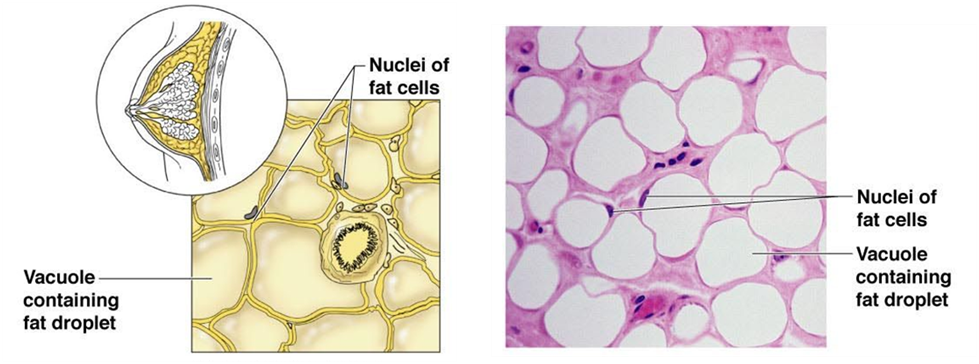
Function
- It serves as a fat reservoir.
- It provides shape to the limbs and the body.
- It keeps visceral organs in position.
- It acts as an insulator.
Skeletal Tissue
The skeletal or supporting tissue includes cartilage and bone which forms the endoskeleton of vertebrate body. It mainly consists of:
- Bone
- Cartilage
Bone
It is very strong and non-flexible tissue. Its matrix is made up of protein that is heavily coated with salts of calcium and magnesium that are responsible for the hardness of the bone. Bone cells called osteoblasts or osteocytes, are present lamellae with fluid-filled spaces is called lacunae.
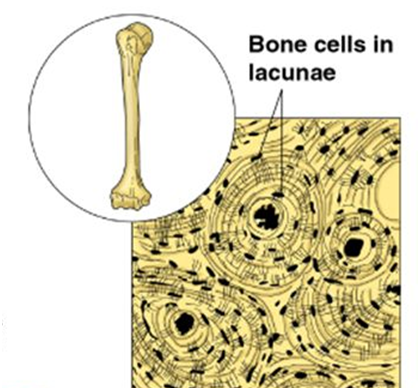
Functions
Bones form endoskeleton of human beings and other vertebrates except the sharks. It serves the following functions.
- It provides shape to the body.
- It provides skeletal support to body,
- It protects vital body organs such as brain, lungs, etc.
- It serves as a storage site of calcium and phosphate.
- It anchors the muscles.
Cartilage-
It has less vascular matrix which is composed of calcium salts. Its cells are called chondrocytes. The matrix of cartilage consists of collagen fibres. Chondrocytes are present in fluid-filled space known as lacunae, blood vessels are absent in matrix. It forms the ear pinna , nose tip, epiglottis, etc.
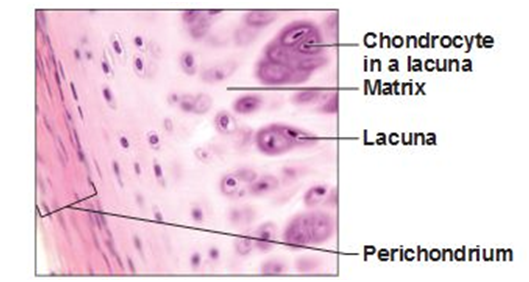
Functions
- It provides support and flexibility to the body parts.
Fluid connective tissue
This tissue helps in creating link between different parts of the body and maintains a continuity of life. They are of two types: Blood and Lymph
Blood It is formed of two components:
- Plasma
- Blood cells
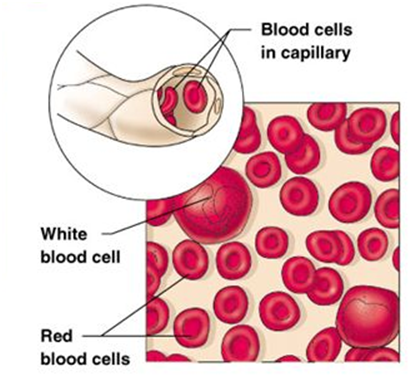
Plasma
It is a yellow colored fluid which is 90% water and 10% organic and inorganic substances. Due to the presence of these substances, it acts as a nutrient medium for blood cells.
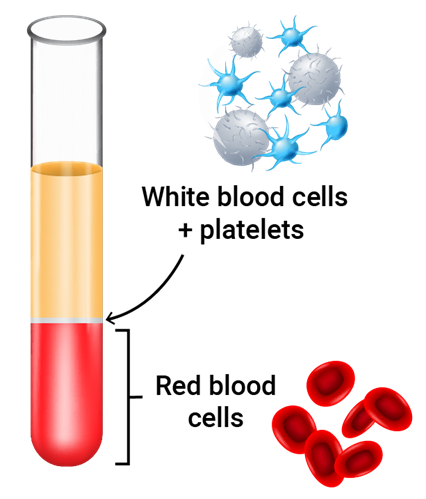
The blood cells present are:
- Red blood cells
- White blood cells
- Platelets
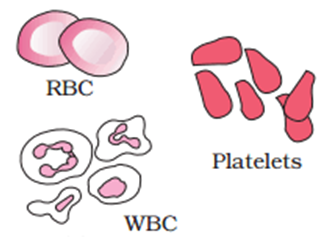
Red blood cells
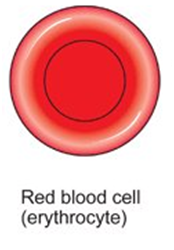
- These are incomplete cells with no nucleus, mitochondria and endoplasmic reticulum
- These cells are the smallest cells of our body.
- They are cells that have disc – like shape.
- These cells have red colour as they contain a pigment made up of iron called haemoglobin.
- The function of this hemoglobin is to transport gases by forming complexes i.e oxyHb and carbinoHb.
- These cells are synthesized in bone marrow of adults and in infants in spleen from stem cells.
- The life span of these cells is 120 days.
- These cells are also called erythrocytes.
White blood cells
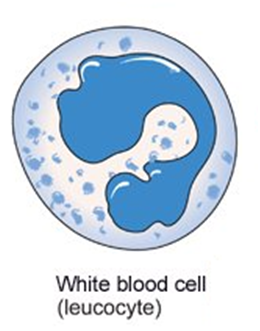
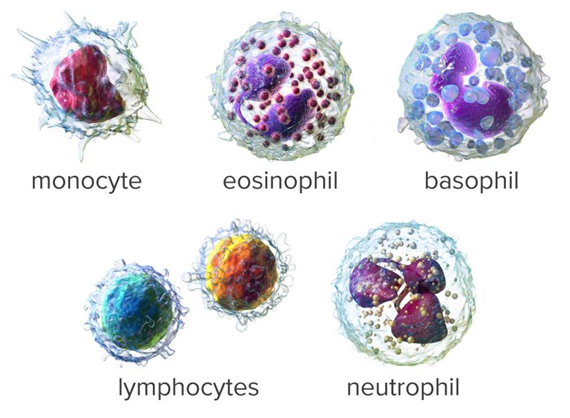
- These cells are irregular in shape and are complete cells enclosing all organelles.
- These cells do not have any pigment in them that is the reason that they have no colour.
- These cells have a life span of 2 to 4 weeks.
- They are also called leucocytes.
- They are also called soldiers of our body as they protect our body from infection causing agents – either they engulf infection causing agent or they secrete certain proteins that make infection causing agent harmless.
Platelets
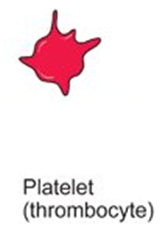
- Platelets are tiny fragments that may or may not have a nucleus.
- Their function is to secrete certain proteins that help in blood clotting.
- Their life span is 60 to 120 days.
- They are also called thrombocytes.
Lymph
It is a colorless fluid that gets filtered out of the blood capillaries.

Functions
- Lymph transports the nutrients (oxygen, glucose) that may have filtered out of the blood capillaries back into the heart to be re-circulated in the body.
- It brings CO2 and nitrogenous wastes from tissue fluid to blood.
- Being loaded with WBCs such as lymphocytes, the lymph protects the body against infection.
- It forms the defense or immune system of the body.
4. Nervous Tissue
- Books Name
- Yash Tyagi Coaching Science Book
- Publication
- ACERISE INDIA
- Course
- CBSE Class 9
- Subject
- Science
Nervous Tissue
Nervous tissue
This tissue helps us in thinking, listening, conveying messages, etc. On the whole, we can say that it helps in control and coordination in the body. It is a specialized tissue that helps in transmitting messages within our body. It contains highly specialized cells called neurons. The neurons have the ability to receive stimuli from within or outside the body and to conduct impulses to different parts. Each neuron consists of:
- Cyton
- Dendrite
- Axon
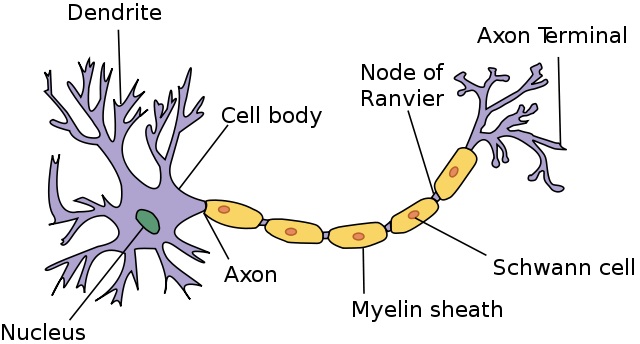
The irregular structure called cell body encloses a nucleus in neuroplasm. From cell body, small branches arise on upper side called dendrite. On the lower side, it gives out only one branch that is elongated called axon. The whole neuron is made up of neurolemma. It has a fatty layer on it as a modulated sheath that creates nodes of ranvier that help in saltatory conduction. Axon ends into nerve endings.
Function of neuron
- It is to form nerves that further helps in control and coordination of body.

 Science Made Easy
Science Made Easy
 ACERISE INDIA
ACERISE INDIA
